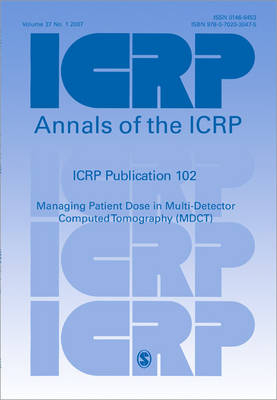
ICRP Publication 102
Elsevier Science Ltd (Verlag)
978-0-7020-3047-5 (ISBN)
Computed tomography (CT) technology has changed considerably in recent years with the introduction of increasing numbers of multiple detector arrays. There are several parameters specific to multi-detector computed tomography (MDCT) scanners that increase or decrease patient dose systematically compared to older single detector computed tomography (SDCT) scanners.
This document briefly reviews the MDCT technology, radiation dose in MDCT, including differences from SDCT and factors that affect dose, radiation risks, and the responsibilities for patient dose management. The document recommends that users need to understand the relationship between patient dose and image quality and be aware that image quality in CT is often higher than that necessary for diagnostic confidence. Automatic exposure control (AEC) does not totally free the operator from selection of scan parameters, and awareness of individual systems is important. Scanning protocols cannot simply be transferred between scanners from different manufacturers and should be determined for each MDCT. If the image quality is appropriately specified by the user, and suited to the clinical task, there will be a reduction in patient dose for most patients. Understanding of some parameters is not intuitive and the selection of image quality parameter values in AEC systems is not straightforward. Examples of some clinical situations have been included to demonstrate dose management, e.g. CT examinations of the chest, the heart for coronary calcium quantification and non-invasive coronary angiography, colonography, the urinary tract, children, pregnant patients, trauma cases, and CT guided interventions. CT is increasingly being used to replace conventional x-ray studies and it is important that patient dose is given careful consideration, particularly with repeated or multiple examinations.
1.MDCT TECHNOLOGY 1.1.Background 1.2.Introduction to MDCT technology 1.3.Differences between SDCT and MDCT 1.4.Upcoming developments 1.5.What is the motivation for this report? 2.RADIATION DOSE IN MDCT 2.1.Introduction 2.2.Are doses in MDCT different and why? 2.3.What are the considerations for users switching over from SDCT to MDCT? 2.3.1.Factors that can increase dose in MDCT 2.3.2.Factors that can decrease dose in MDCT 2.4.Dose surveys and diagnostic reference levels 2.5.Perspective on radiation risks 2.5.1.Deterministic risk 2.5.2.Stochastic risk 2.6.Responsibilities for patient dose management 3.WHAT CONSIDERATIONS AND ACTIONS AFFECT PATIENT DOSE? 3.1.Compromise between dose and image quality 3.1.1.General descriptors of image quality 3.1.2.Different imaging tasks require different levels of quality 3.2.Equipment and protocol issues affecting patient dose 3.2.1.Overbeaming 3.2.2.Overranging 3.2.3.Image thickness 3.3.Operator choices that affect patient dose 3.3.1.Scanner model and manufacturer 3.3.2.Tube current (mA) and tube current-exposure time product (mAs) 3.3.3.Image quality selection paradigms 3.3.4.Temporal mA modulation 3.4.Tube voltage (kVp) 3.5.Pitch, beam collimation and slice width 3.6.Scan coverage and indication 3.7.System Software: Image reconstruction, noise reduction, and metal artefact reduction algorithms 3.8.Modification of scan acquisition and reconstruction parameters 4.DOSE MANAGEMENT IN CLINICAL PRACTICE 4.1.Justification of examination 4.2.Training issues 4.3.Techniques and doses for particular CT examinations 4.3.1.Chest CT 4.3.2.CT for coronary calcium quantification and non-invasive coronary angiography 4.3.3.CT colonography 4.3.4.CT for trauma 4.3.5.CT of the urinary tract 4.3.6.CT-guided interventions 4.3.7.CT in children 4.3.8.CT of the pregnant patient 4.3.9 Future directions APPENDIX A. HOW TO DESCRIBE DOSE IN CT
| Erscheint lt. Verlag | 3.1.2008 |
|---|---|
| Reihe/Serie | Annals of the ICRP |
| Verlagsort | London |
| Sprache | englisch |
| Gewicht | 170 g |
| Themenwelt | Medizinische Fachgebiete ► Radiologie / Bildgebende Verfahren ► Computertomographie |
| ISBN-10 | 0-7020-3047-3 / 0702030473 |
| ISBN-13 | 978-0-7020-3047-5 / 9780702030475 |
| Zustand | Neuware |
| Haben Sie eine Frage zum Produkt? |
aus dem Bereich


